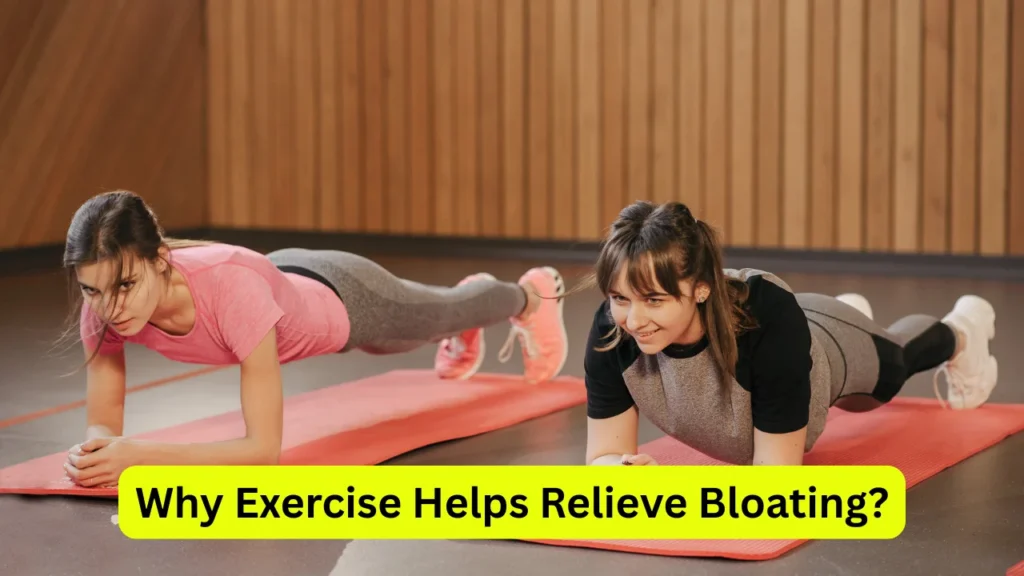Introduction
Have you ever felt your belly puff up like a balloon after eating? That tight, uncomfortable pressure is bloating — and it can strike anyone. The good news is that the right bloating stomach exercises can ease gas, support digestion, and leave you feeling light again.
Whether you prefer bloating stomach exercises in bed, after meals, or at night, this guide walks you through gentle movements that calm your core, reduce discomfort, and restore balance. These are simple, low-impact routines suitable for both men and women, no matter your fitness level.
Understanding Bloating and Its Causes

Why Your Stomach Bloats
Bloating is often the body’s way of signaling digestive slowdown. Common reasons include:
- Eating too quickly or swallowing air
- Constipation or slow intestinal movement
- Gas buildup from certain foods
- Food intolerances or sensitivities
- Hormonal changes
- Sedentary habits or lack of movement
- Stress-related gut tension
When gas and fluid collect in your intestines, your belly can look and feel bigger. Regular bloating stomach exercises help counter this by promoting natural gas release and better circulation.
Typical Symptoms
You may experience:
- Abdominal pressure or fullness
- Gurgling or rumbling sounds
- Excessive gas or burping
- Mild pain or cramping
- Temporary weight increase
- Difficulty buttoning pants
If your bloating occurs frequently or comes with severe pain, consult a doctor before starting any new routine.
Why Exercise Helps Relieve Bloating?

Physical movement speeds up digestion by stimulating intestinal muscles. It encourages trapped gas to move through your system and reduces abdominal tightness. Even light stretching can make a noticeable difference.
When you engage your core muscles gently, you boost blood flow to the digestive organs. This improves oxygen delivery, supports enzyme function, and relieves discomfort naturally — without pills or supplements.
Key benefits of bloating stomach exercises include:
- Promotes gas expulsion
- Improves intestinal transit
- Enhances posture and breathing
- Reduces water retention
- Calms stress that contributes to IBS or indigestion
Best Bloating Stomach Exercises
These exercises are designed for every situation — whether you’re lying in bed, sitting at work, or working out in the gym.
1. Bloating Stomach Exercises in Bed
These movements are ideal for nighttime or early-morning relief.
Knees to Chest (Wind-Relieving Pose)
Lie on your back, draw both knees toward your chest, and hug them gently. Breathe slowly as you hold for 30 seconds. This motion massages your intestines and releases trapped gas.
Supine Spinal Twist
Keep knees bent and let them fall to one side while arms stretch out. It improves spinal flexibility and supports digestion.
Child’s Pose
Kneel, bring your forehead to the bed, and stretch arms forward. This gentle compression reduces bloating and stress.
Happy Baby Stretch
Hold your feet, spread knees slightly wider than your torso, and rock side to side. This opens the hips and eases belly pressure.
Pelvic Tilt in Bed
Bend your knees and press your lower back into the mattress, then lift slightly. This engages your core without strain.
2. Bloating Stomach Exercises After Eating
Doing mild movements after meals helps food travel smoothly through your digestive tract.
Light Walking
A slow 10-minute walk aids digestion and prevents gas buildup. Avoid brisk walking immediately after eating — keep it gentle.
Seated Torso Twists
Sit upright, place your hands on your knees, and twist gently from side to side. This loosens tight abdominal muscles.
Standing Side Bends
Stand tall, place one hand on your hip, and reach the other arm overhead. Alternate sides to reduce tension and support digestion.
Ankle to Knee Sit-Stretch
Cross one ankle over the opposite knee while seated. Lean forward slowly — this opens your abdomen and relieves lower-belly tightness.
3. Core-Focused Exercises for Digestion
Strong, flexible core muscles aid natural bowel movement and prevent gas from lingering.
Cat-Cow Stretch
Move between arching your back upward (Cat) and dipping it downward (Cow). The gentle motion improves intestinal flow.
Bridge Pose
Lie on your back, bend knees, and lift hips upward. This pose tones your lower abs and promotes circulation.
Transverse Abdominal Vacuum
Exhale fully, draw your belly inward toward your spine, hold, then release. It strengthens deep abdominal muscles and supports digestion.
Gentle Leg Raises
Lying down, lift one leg at a time to 45 degrees and lower slowly. This keeps your lower abdomen active without strain.
Pelvic Bridge Pulse
Lift hips halfway up and pulse gently 10–15 times. This encourages peristaltic movement in the intestines.
4. Yoga Poses for Bloating and Gas
Yoga blends breath and movement to calm the nervous system while aiding digestion.
Seated Forward Fold
Sit with legs straight and lean forward. It compresses abdominal organs and improves digestion.
Downward-Facing Dog
From hands and feet on the floor, lift hips upward. It stretches the spine and releases gas pockets.
Garland Squat (Malasana)
Squat deeply with elbows pressing against knees. This posture opens the hips and promotes bowel movement.
Bridge Pose
Lift your hips while keeping shoulders grounded. It enhances blood circulation in your digestive organs.
Reclined Spinal Twist
Lie down and cross one knee over the other. Twist your torso for a slow massage effect on the intestines.
5. Bloating Stomach Exercises for Men and Women
Both men and women benefit from these, though hormonal cycles and abdominal fat distribution can influence results.
| Exercise Type | Benefit | Suitable For |
|---|---|---|
| Wind-Relieving Pose | Gas release, flexibility | Men & Women |
| Bridge Pose | Core toning, digestion | Men & Women |
| Light Walking | Improves motility | All Ages |
| Garland Squat | Reduces water retention | Women (esp. PMS) |
| Cat-Cow Stretch | Reduces gas and stress | Men & Women |
Consistency is key. Perform these daily for 10–20 minutes, and you’ll notice your stomach feels lighter and flatter.
Sample Daily Routine for Bloating Relief
| Time | Routine | Duration | Focus |
|---|---|---|---|
| Morning | Knees to Chest, Bridge Pose | 10 min | Wake up digestion |
| After Meals | 10-minute Walk, Seated Twists | 15 min | Prevent gas |
| Evening | Cat-Cow, Forward Fold, Child’s Pose | 15 min | Calm stomach |
| Before Bed | Supine Twist, Happy Baby | 10 min | Release gas before sleep |
Adjust timing as needed — even a few minutes can help if you’re consistent.
Additional Lifestyle Tips
Eat and Drink Mindfully
- Chew food thoroughly and avoid gulping drinks.
- Limit carbonated beverages and artificial sweeteners.
- Drink warm water instead of cold to support digestion.
Support Gut Health
- Include probiotics and fiber-rich foods.
- Avoid sudden changes in diet.
- Stay hydrated to prevent constipation.
Avoid Tight Clothing
Tight belts or waistbands compress your abdomen and make bloating worse. Wear breathable, relaxed clothing instead.
Manage Stress
Stress tightens gut muscles. Practice deep breathing, meditation, or gentle yoga daily to calm your digestive system.
Rest Well
Poor sleep disrupts digestion and hormone balance. Aim for 7–8 hours each night, ideally doing bloating stomach exercises before bed for relaxation.
Common Mistakes During Bloating Exercises
| Mistake | Why It’s a Problem | Fix |
|---|---|---|
| Doing high-intensity workouts after meals | Can trap gas and worsen discomfort | Wait 30–60 minutes after eating |
| Holding breath during stretches | Increases internal pressure | Breathe deeply through the nose |
| Rushing movements | Reduces effectiveness | Move slowly and with control |
| Skipping cool-down stretches | Muscles stay tight | End with relaxation poses |
| Ignoring hydration | Slows digestion | Drink water throughout the day |
Avoiding these mistakes helps you get the most from your daily bloating stomach exercises routine.
When to See a Doctor
If bloating is accompanied by pain, nausea, vomiting, or unexplained weight loss, seek professional evaluation. Persistent bloating might indicate conditions like IBS, food intolerance, or gastritis. Exercise helps, but proper diagnosis ensures long-term relief.
Frequently Asked Questions
1. Can bloating stomach exercises be done daily?
Yes. Gentle stretches, yoga, and light walks are safe for daily use. Avoid intense workouts when you’re feeling overly full.
2. Do these exercises burn belly fat?
They mainly relieve gas and bloating, not fat. However, regular movement improves metabolism, which helps over time.
3. When is the best time to do them?
Morning or after meals works best. At night, choose relaxed poses like knees-to-chest or spinal twists.
4. Can I do them during menstruation?
Yes, most are safe and even helpful. Poses like Child’s Pose or Garland Squat reduce cramps and bloating.
5. How long before I see results?
Some people feel lighter after one session. Consistency for 1–2 weeks brings visible improvement in comfort and digestion.
Also Read: Castor Oil for Constipation
Final Thoughts
Bloating doesn’t have to disrupt your day. With simple, consistent bloating stomach exercises, you can stimulate digestion, release gas, and improve gut comfort naturally. Whether you stretch in bed, walk after lunch, or use yoga before sleep, gentle movement is your best tool for lasting relief.
Make these exercises part of your daily wellness routine — and say goodbye to the heavy, bloated feeling once and for all.

Dr. Max is a dedicated medical professional with extensive experience in health and wellness. His approach blends clinical expertise with the latest research, offering practical insights to help individuals lead healthier, more balanced lives.

